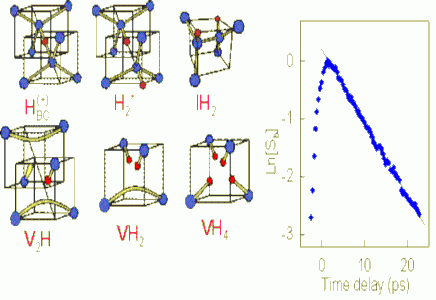Dynamics of Impurities in Semiconductors

Red dots indicate hydrogen atoms in the silicon lattice, shown as blue dots. The time response of the excited HBC case is depicted in the graph
Additional Links
Silicon is perhaps one of the most important materials in our technological world, but its performance is always ultimately limited by impurities. Mitigation by impurity elimination is not possible, and theoretical understanding is very limited. Thus, these experiments, in which real-time dynamical evolution of excited impurity dynamics is measured, are of high fundamental as well as technological importance.
The principle behind the experiments is to use two photons, both tuned to a "color" or wavelength, at which the impurities absorb energy. The first photon is absorbed by the impurity, and the second one interrogates the impurity to study how the energy dissipates in the time following the first photon– like hitting a piano key and listening to the consequences in time.
The experiments were led by Gunter Luepke of The College of William & Mary. The group measured many impurity modes of hydrogen in silicon and were also able to compare their behavior with that of deuterium (an isotope of hydrogen), which behaves quite differently even though it is electronically similar.
References:
Luepke et al.
Phys. Rev. Letts 85, 1452 2000
Phys. Rev. Letts 88, 135501, 2002
Phys. Rev. Letts 87, 145501, 2001
Phys. Rev. B63 195203 2001
J. Appl. Phys. 93 2316, 2003

